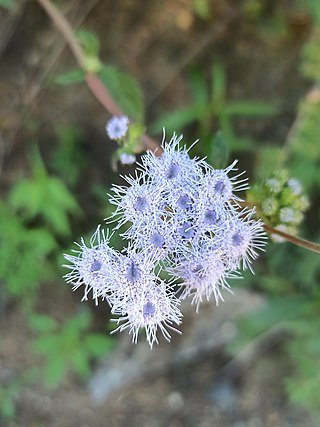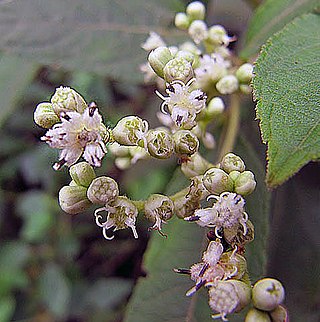
Ichthyothere is a genus of flowering plants, found in parts of South America and Central America.

Ageratum is a genus of 40 to 60 tropical and warm temperate flowering annuals and perennials from the family Asteraceae, tribe Eupatorieae. Most species are native to Central America and Mexico but four are native to the United States.

Polygonum is a genus of about 130 species of flowering plant in the buckwheat and knotweed family Polygonaceae. Common names include knotweed and knotgrass. In the Middle English glossary of herbs Alphita, it was known as ars-smerte. There have been various opinions about how broadly the genus should be defined. For example, buckwheat has sometimes been included in the genus as Polygonum fagopyrum. Former genera such as Polygonella have been subsumed into Polygonum; other genera have been split off.
Harold Ernest Robinson was an American botanist and entomologist.

Eupatorieae is a tribe of over 2000 species of plants in the family Asteraceae. Most of the species are native to tropical, subtropical, and warm temperate areas of the Americas, but some are found elsewhere. Well-known members are Stevia rebaudiana, a number of medicinal plants (Eupatorium), and a variety of late summer to autumn blooming garden flowers, including Ageratum (flossflower), Conoclinium (mistflower), and Liatris.

Edward William Nelson was an American naturalist and ethnologist. A collector of specimens and field naturalist of repute, he became a member of several expeditions to survey the fauna and flora. He was part of a team with Clinton Hart Merriam that took part in the Death Valley Expedition. He also explored the Yosemite Valley. A number of vertebrate species are named after him.

Aequatorium is a genus of flowering plants in the aster family. It was described as a genus in 1978. It is a member of the tribe Senecioneae and native to South America.

Clibadium is a genus of flowering plants in the family Asteraceae.
Fleischmannia obscurifolia is a species of flowering plant in the family Asteraceae. It is found in Ecuador and Colombia. Its natural habitats are subtropical or tropical moist lowland forests and subtropical or tropical moist montane forests. It is threatened by habitat loss.
Hebeclinium is a genus of flowering plants in the family Asteraceae, native to South America and Mesoamerica.

Liabum is a genus of South American flowering plants in tribe Liabeae of the family Asteraceae.

Munnozia is a genus of flowering plants in the family Asteraceae. It is centered in the Andes.

Pentacalia is a genus of flowering plants in the family Asteraceae. About 34 members of this genus appear to be located in the South American county Ecuador, where they are threatened by habitat loss. The genus contains approximately two hundred species, which are distributed from Mexico to northern South America.

Paul Carpenter Standley was an American botanist known for his work on neotropical plants.
Acritopappus is a genus of flowering plants in the family Asteraceae described as a genus in 1972.
Grazielia is a genus of South American flowering plants in the family Asteraceae.
Lourteigia is a genus of South American flowering plants in the tribe Eupatorieae within the family Asteraceae.
Graziela Maciel Barroso (1912-2003) was a Brazilian botanist noted for being a leading expert on the flora of Brazil, as well as a specialist of Compositae. She was Chairman and Professor of the Department of Plant Biology at the University of Brasília, and published the three-volume Sistemática de Angiospermas do Brasil.
Mexotis is a genus of flowering plants belonging to the family Rubiaceae.










